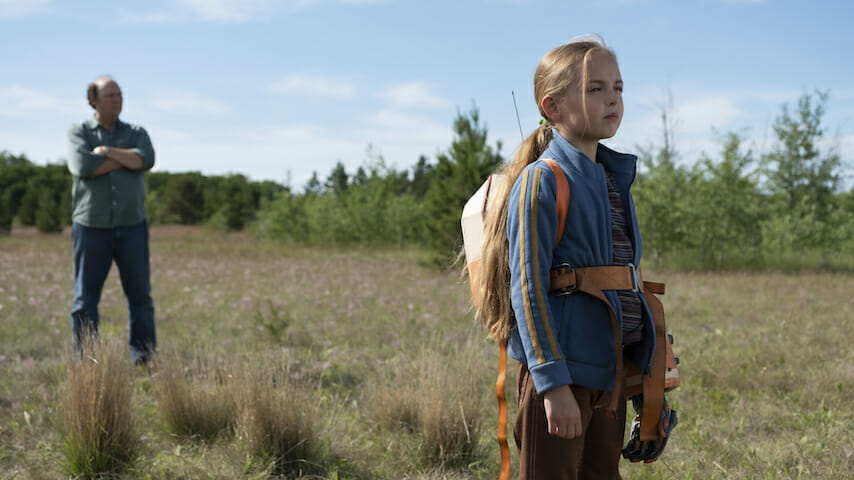Amazon’s Tales from the Loop Is Intimate, Irresistible Science-Fiction
Photo Courtesy of Amazon TV Reviews Tales from the Loop
A small town can become so self-contained and isolated, so self-involved in its own goings-on, that it can feel like a reality all its own. In Mercer, Ohio, the Midwestern setting of Amazon’s Tales from the Loop series, that feeling is magnified by a synecdoche of strangeness: The Loop, a device that’s fantastical physical function is left as vague as the intentions of its creator Russ (Jonathan Pryce). The thrumming black sphere at its center, locked beneath a concrete facility filled with scientists and mathematicians, makes the impossible possible. Life, otherwise, goes on. With limited explanation and an excess of empathy, the stark and lovely vignettes are a touching blend of intimacy and otherworldliness, like diary entries sent from an alternate dimension.
Creator Nathaniel Halpern adapts Swedish artist Simon Stålenhag’s sci-fi source of the same name, which blends alt-history anthropology and techno-archeology, into this reimagined and loosely linked anthology. Americanized to Ohio, the stories of Mercer play out like the Voyager’s Golden Records—teaching viewers from another world how the basic elements of life work in this realm. Memory, loss, regret, loneliness, even unrepentant horniness—Tales from the Loop skews less Black Mirror than it does the best episodes of Twilight Zone, where the genre setting merely kickstarts a more evocative piece of naturalist drama. Sometimes the sci-fi elements add layers and depth, but they often just support and color the humanity Halpern writes into the stories.
Mercer is a one-company town—sometimes beautiful in its simplicity, sometimes bleak, beige, and brutal—peppered with Star Wars-like sci-fi mundanity. Robots aren’t shiny and new; mechanical wonders are used to dispose of garbage. Retro Middle American frump becomes all the more impressive because it takes its impossible components for granted. It’s reflected in the fashion, where color-coded kids listen to adults decked out in refracted Americana (mimicking something like Japanese brand Engineered Garments’ take on traditional workwear), as well as the storylines, which deal with growing up, death, and love. The show retains its Swedish roots only subtly, with Ingmar Bergman’s Summer with Monika marqueed on the local theater, and a tempo more inclined to take things in half time.
In the three episodes I was given to review (the season’s first, fourth, and sixth), Tales from the Loop spins Steven Spielberg’s Amblin yarns in their most mature form. A child’s perspective brushes against adult problems, while adulthood’s complexities find uncanny solutions. The natural paraphernalia of childhood—fireflies in jars, strange rocks, pristine pinecones—are just as prevalent as the supernatural. Life and death are seen from between the leaves of a climbed tree. Cole (Duncan Joiner) is a charming guide through all this. Rebecca Hall, who plays his mother Loretta, is excellent while Ato Essandoh, who’s already made a name for himself by becoming a meme from various small roles (he’s the “Jesus Christ, it’s Jason Bourne” guy) finally gets the breakout role he’s deserved.
That all takes place in the sixth episode, where The One I Love’s Charlie McDowell retreads ground filled with imperfect love and imperfect doubles. His and director Mark Romanek’s first episode are both great and touching, but it’s Andrew Stanton’s fourth episode that hits you in the gut. One of Pixar’s melancholy best (WALL-E) is turned loose on a poignant hour that comes at a time when mortality is in the forefront of society’s consciousness: if you’re craving an ugly cry, Stanton gives you all you need to let it out. It helps that Pryce is Stanton’s muse throughout the episode. (We are all blessed by Jonathan Pryce.)
The episodes all feel quite different in tone, though with the resonating similarity of the universe. It’s good worldbuilding adapted into good worldbuilding—each episode sounds like a story you could hear over a night sitting at a strange city’s single bar. And since they share the same writer (Halpern), the strengths and weaknesses persist despite plot differences or aesthetic choices. Romanek’s gorgeous, tactile use of hands and shadows coupled with McDowell’s crushing silhouettes are linked by the narratives’ pros and cons. Halpern’s plots are moving and meaty, but the dialogue can sometimes hit a little on the nose for an otherwise poetic show (as can the intense musical cues).
Ultimately, however, Tales from the Loop is that rare sci-fi show: one that trusts us to breathe in deep the oddities of its world, accept that we aren’t going to know everything, and climb aboard anyways. That trust, built with its tactful scene-setting and human-sized troubles, allows for easy investment in deceivingly simple dramas. If the rest of the episodes are as touching, moving, and casually engaging as what I’ve seen from The Loop, Amazon already has one of the year’s sharpest pieces of sci-fi.
Tales from the Loop premieres April 3rd on Amazon Prime.
Jacob Oller is a film and TV critic whose writing has appeared in The Guardian, The Hollywood Reporter, Vanity Fair, Interview Magazine, Playboy, SYFY WIRE, Forbes, them, and other publications. He lives in Chicago with his two cats and a never-ending to-do list of things to watch. He likes them (the cats and the list) most of the time. You can follow him on Twitter here: @jacoboller.
For all the latest TV news, reviews, lists and features, follow @Paste_TV.